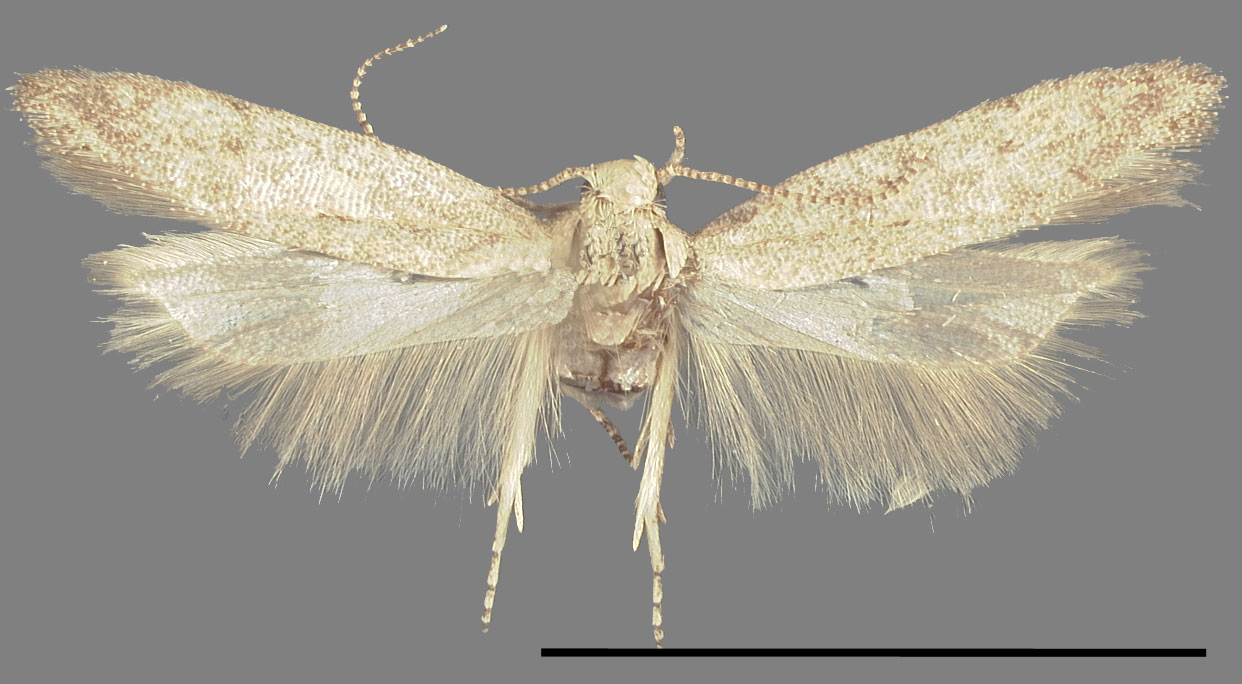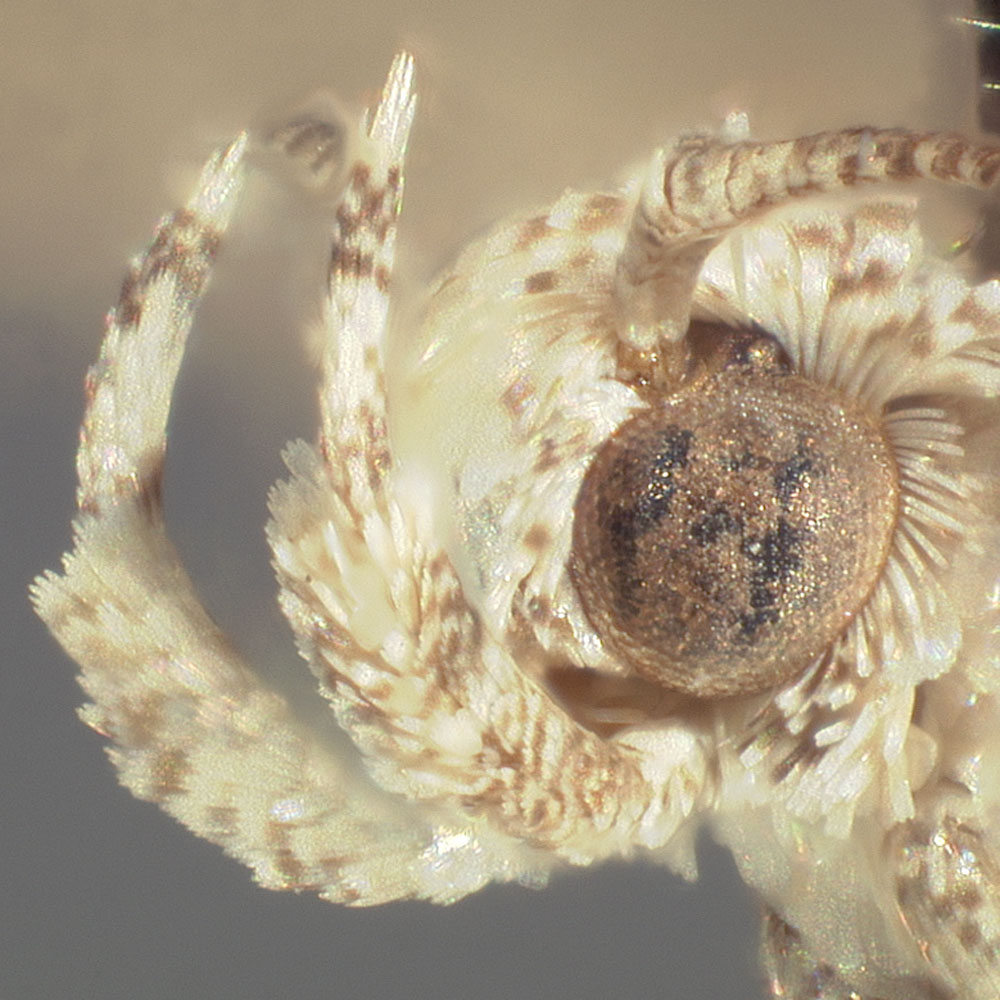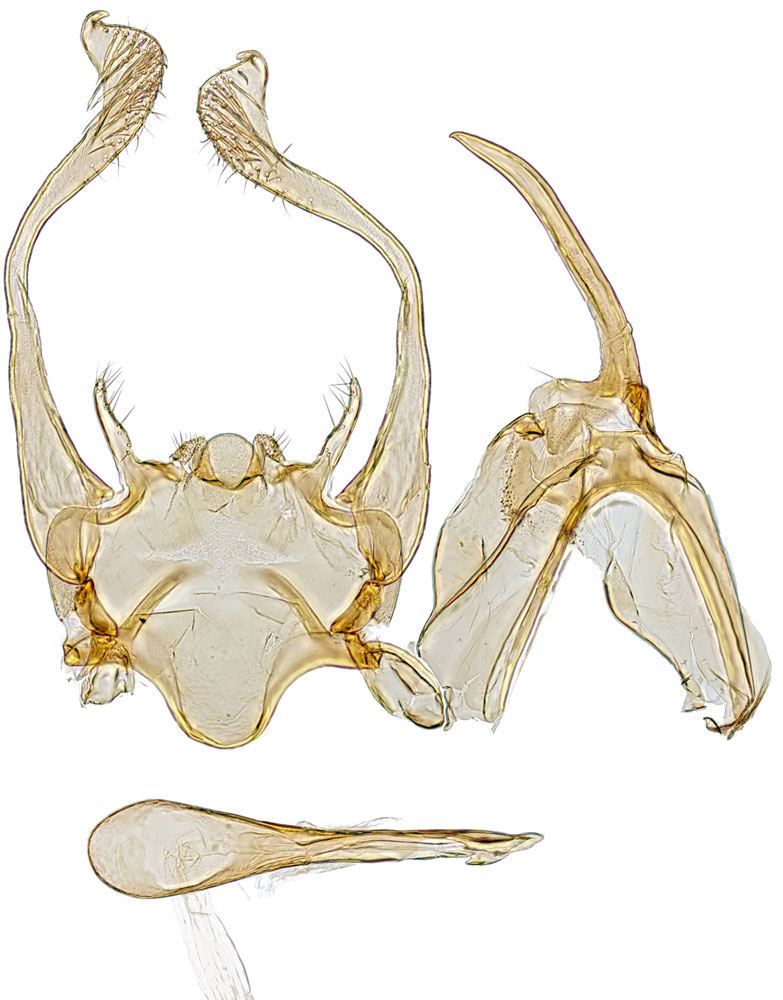Keiferia glochinella
|
Keiferia glochinella habitus. Scale = 5 mm. |
|
Keiferia glochinella head. |
|
Keiferia glochinella male genitalia. |
|
Keiferia glochinella female genitalia. |
Name
Keiferia glochinella (Zeller, 1873)
Common name: eggplant leafminer moth
Original combination: Gelechia glochinella Zeller, 1873
Synonyms: Keiferia peniculo Heinrich, 1946
Alternative combinations: Tildenia peniculo (Heinrich, 1946)
Classification: Gelechioidea: Gelechiidae: Gelechiinae: Gnorimoschemini
Adult recognition
Adults are about 4.5–5.0 mm in forewing length. They are variable yellowish gray, light gray to gray, mottled with dark gray and yellowish-orange. The labial palpusLabial palpus:
The more prominent, elongate pair of appendages on the head, usually three-segmented (pl. palpi).
-800px.jpg) is upturned. The hindwing is trapezoidal, with hair-pencils above from the base of the costal margin in males. The abdomen is yellowish gray and the ventral surface very light dull yellow, modified with long hair-pencils in males. The male genitalia have a sickle-shaped uncusUncus:
is upturned. The hindwing is trapezoidal, with hair-pencils above from the base of the costal margin in males. The abdomen is yellowish gray and the ventral surface very light dull yellow, modified with long hair-pencils in males. The male genitalia have a sickle-shaped uncusUncus:
The prominent projection from the dorsal tegumen of the male genitalia. May be variously shaped as a hook, knob, hood, etc.
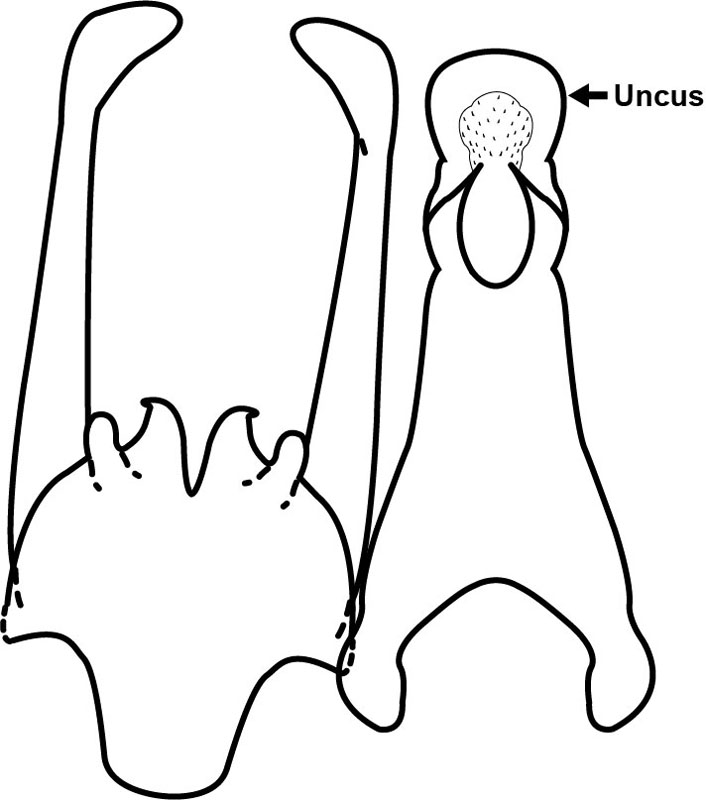 , elongate valvaValva:
, elongate valvaValva:
One of the pair of large lateral appendages of the male genitalia (pl. valvae).
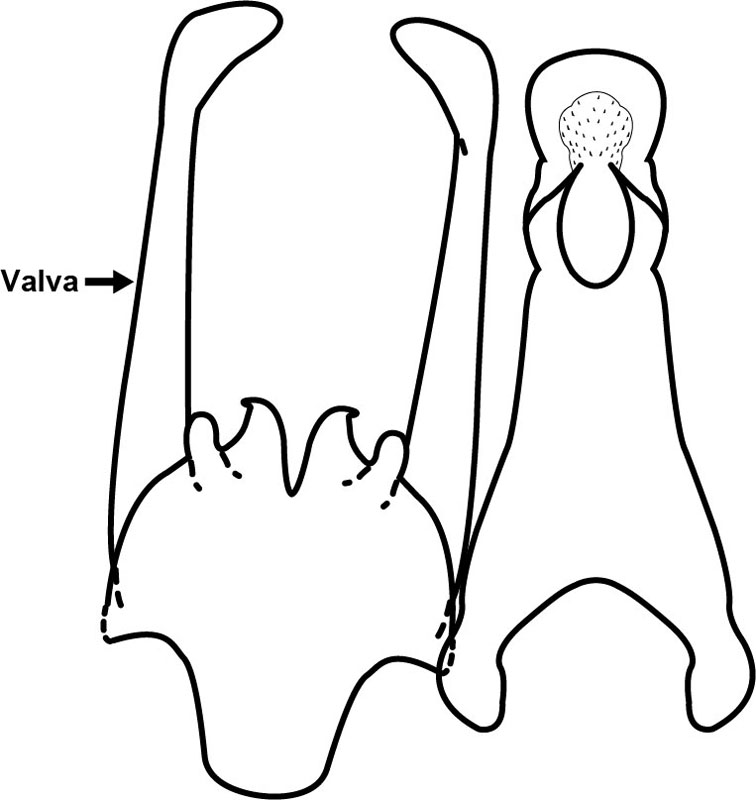 enlarged toward the apex with a small terminal hook, and vinculumVinculum:
enlarged toward the apex with a small terminal hook, and vinculumVinculum:
The ventral half of the male genitalia, from which the valvae arise.
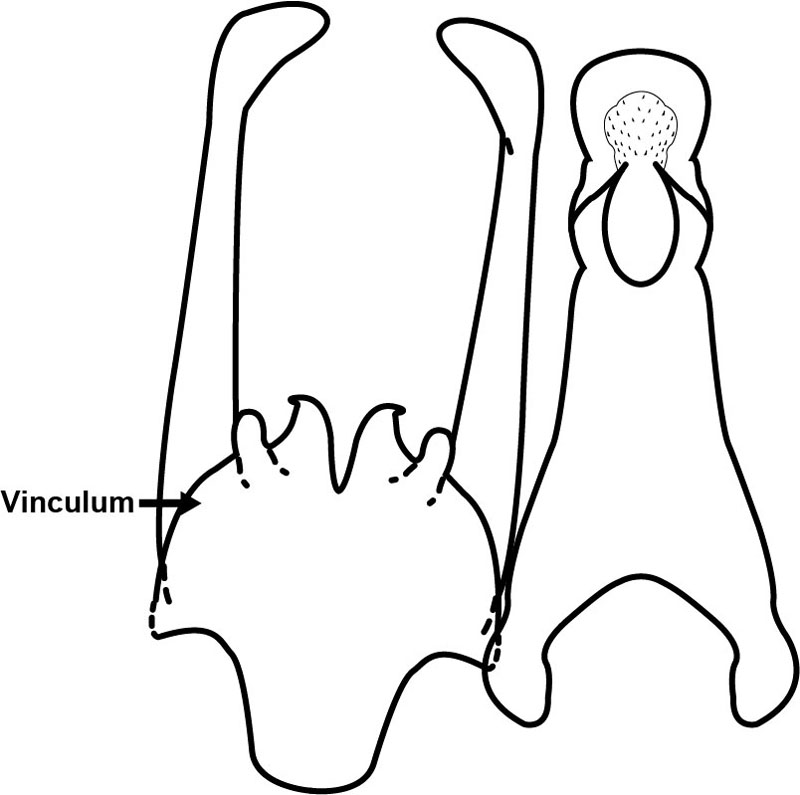 with a paired short hump-like processes. Females have a slightly widened ductus bursaeDuctus bursae:
with a paired short hump-like processes. Females have a slightly widened ductus bursaeDuctus bursae:
The usually narrow duct between the ostium and antrum and the corpus bursae.
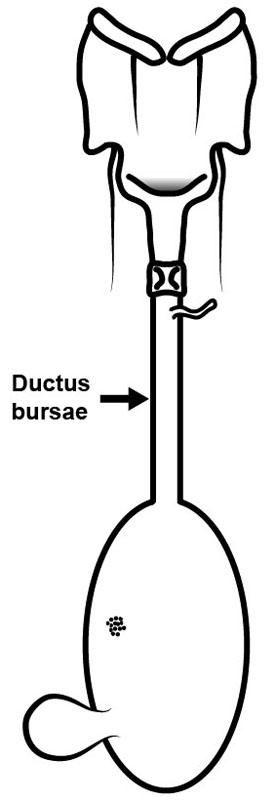 as long as the corpus bursaeCorpus bursae:
as long as the corpus bursaeCorpus bursae:
The enlarged, bulbous anterior end of the female genitalia.
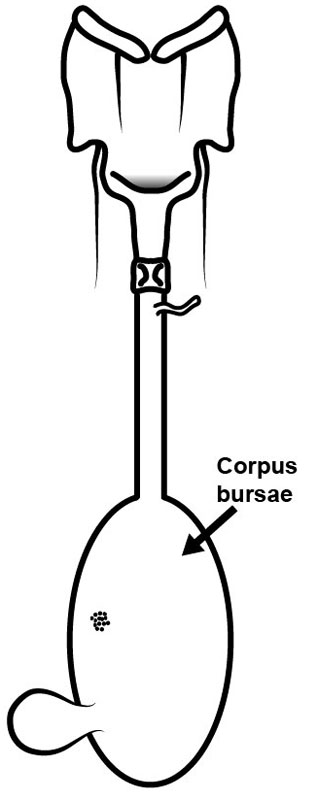 , the ostium with hood-shaped sclerotization, and a hook-shaped signumSignum:
, the ostium with hood-shaped sclerotization, and a hook-shaped signumSignum:
Any sclerite, sclerotized area, or discrete granular area on the wall of the corpus bursae (pl. signa).
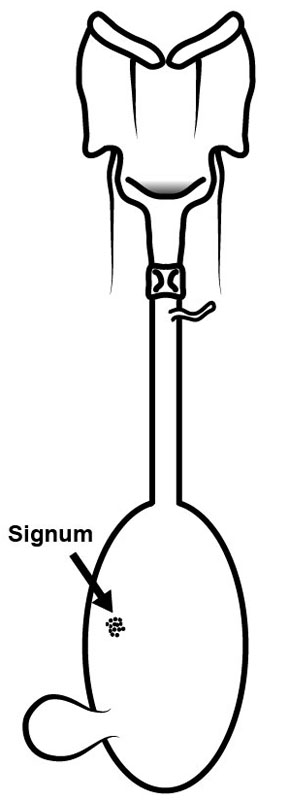 .
.
Immature stages
Larvae when fully grown are about 8 mm long, somewhat semi-cylindrical in shape, the dorsal surface being convex and the ventral surface flattened. The body gradually tapers from the first abdominal segments to the posterior end and is plainly constricted at the junctures of the segments. The head is flattened dorso-ventrally and in living specimens is often partially retracted within the thorax. No detailed morphological descriptions of the mouthparts or chaetotaxyChaetotaxy:
The pattern of setae on the larva.
have been published.
PDF - Dichotomous key to Gelechiid larvae
Similar species
This species is superficially similar to Keiferia lycopersicella, but it differs by having the following genital characters: male valvaValva:
One of the pair of large lateral appendages of the male genitalia (pl. valvae).
 with a small terminal hook, saccusSaccus:
with a small terminal hook, saccusSaccus:
A ventral extension of the vinculum, between the valvae.
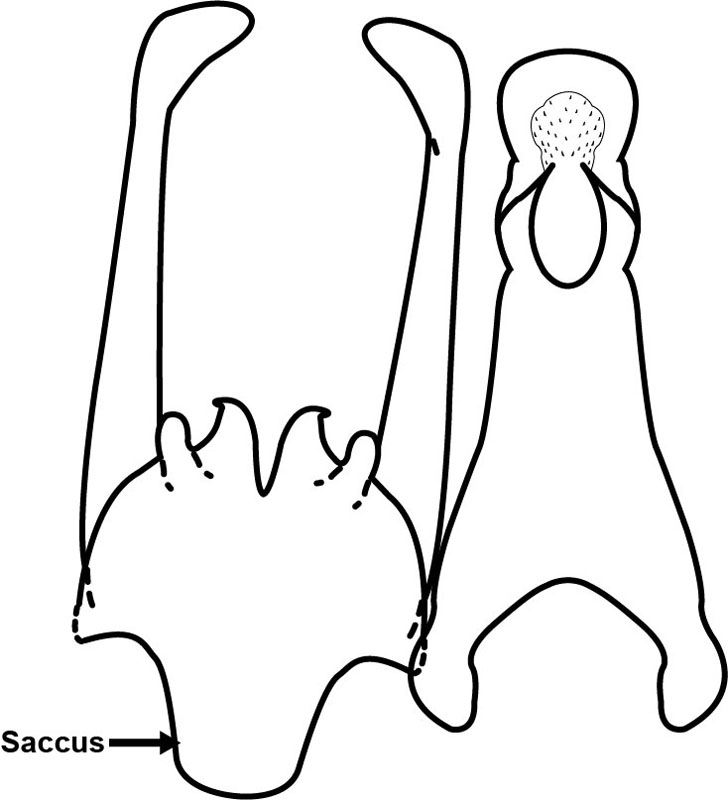 short and broadly rounded, and vincular processes hump-like, whereas in K. lycopersicella, the male valvaValva:
short and broadly rounded, and vincular processes hump-like, whereas in K. lycopersicella, the male valvaValva:
One of the pair of large lateral appendages of the male genitalia (pl. valvae).
 is apically bifurcate, the saccusSaccus:
is apically bifurcate, the saccusSaccus:
A ventral extension of the vinculum, between the valvae.
 is long and thin, and the vincular processes are elongate and finger-like. The female antrumAntrum:
is long and thin, and the vincular processes are elongate and finger-like. The female antrumAntrum:
Posterior section of the ductus bursae, posterior of the colliculum.
 is short in K. glochinella, whereas the antrumAntrum:
is short in K. glochinella, whereas the antrumAntrum:
Posterior section of the ductus bursae, posterior of the colliculum.
 is long and funnel-shaped in K. lycopersicella.
is long and funnel-shaped in K. lycopersicella.
Without information on larval morphology, the larva of K. glochinella has to be identified by the host, distribution and habits. In particular, it is a western United States species that could be confused with Keiferia lycopersicella, K. inconspicuella and Phthorimaea operculella when feeding on Solanum carolinense. The head of K. glochinella is flattened (unlike the round head of P. operculella) and there is likely no posterior band on the prothoraxProthorax:
The first thoracic segment (T1) of any life stage.
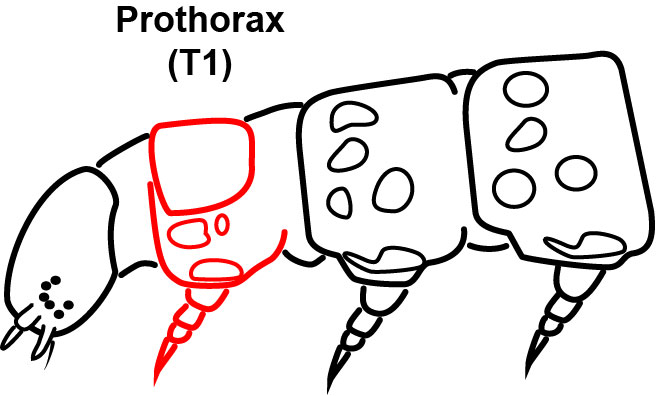 as in K. lycopersicella. Where K. glochinella and K. inconspicuella overlap in Texas, rearing to the adult stage will be necessary until the larva of K. glochinella is described with certainty.
as in K. lycopersicella. Where K. glochinella and K. inconspicuella overlap in Texas, rearing to the adult stage will be necessary until the larva of K. glochinella is described with certainty.
Behavior
Larvae are leaf-miners.
Distribution
Native to North America. USA (Texas, New Mexico, California).
Hosts
Solanum carolinense L. (Carolina horsenettle)
Comments
This species was known as a pest of eggplant in the southwestern United States, but these records were based on misidentifications.
Literature
Busck 1903Busck 1903:
Busck A. 1903. A revision of the American moths of the family Gelechiidae, with descriptions of new species. Proceedings of the United States National Museum 25: 767-938, pl. XXVIII-XXXII.
Busck 1939Busck 1939:
Busck A. 1939. Restriction of the genus Gelechia (Lepidoptera: Gelechiidae), with descriptions of new genera. Proceedings of the United States National Museum 86: 563-593, pl. 58-71.
Chambers 1878Chambers 1878:
Chambers VT. 1878. Index to the described Tineina of the United States and Canada. Bulletin of the United States Geological and Geographical Survey of the Territories 4: 125ndash167.
Heinrich 1946Heinrich 1946:
Heinrich C. 1946. A new species of Keiferia on eggplant (Lepidoptera: Gelechiidae). Proceedings of the Entomological Society of Washington 48: 35-36.
Hodges 1985Hodges 1985:
Hodges RW. 1985. A new species of Tildenia from Illinois (Gelechiidae). Journal of the Lepidopterists#39; Society 39: 151-155.
Povolný 1967Povolný 1967:
Povolný D. 1967. Genitalia of some Nearctic and Neotropic members of the tribe Gnorimoschemini (Lepidoptera, Gelechiidae). Acta Entomologica Musei Nationalis Pragae 37: 51–127.
Zeller 1873Zeller 1873:
Zeller PC. 1873. Beitrauml;ge zur Kenntniss der nordamericanischen Nachtfalter, besonders der Microlepidopteren. Verhandlungen der Kaiserlich-Kouml;niglichen Zoologisch-Botanischen Gesellschaft in Wien 23: 201-334, Taf. III-VI.

